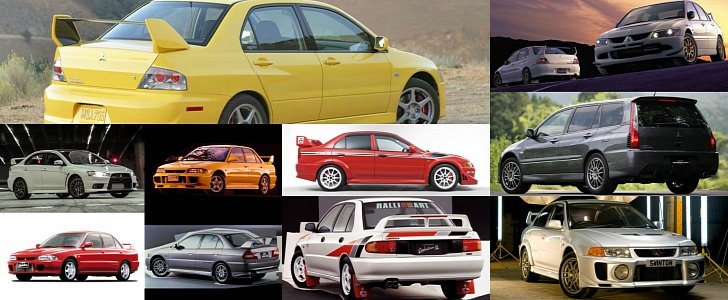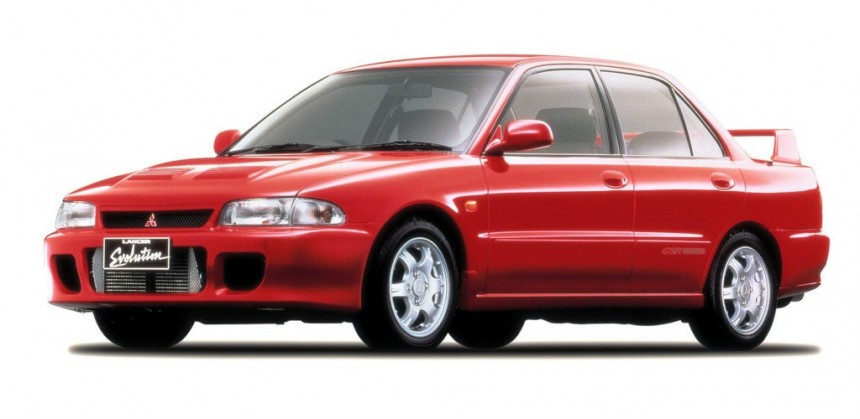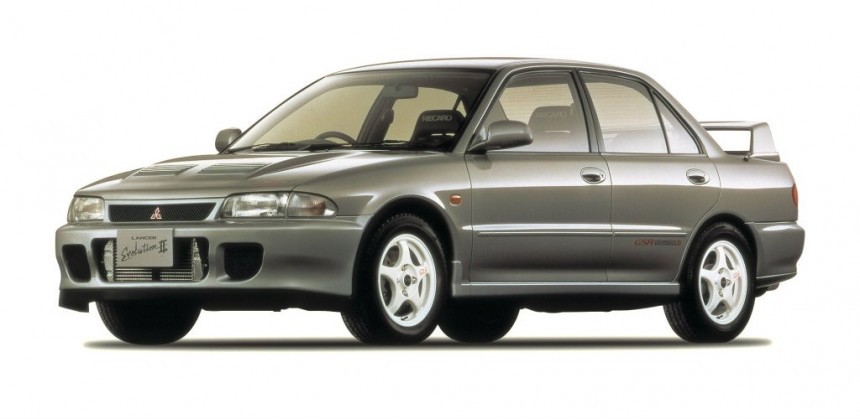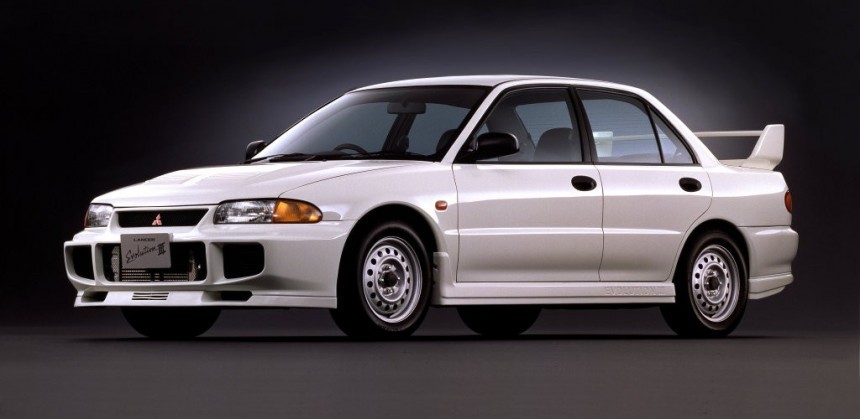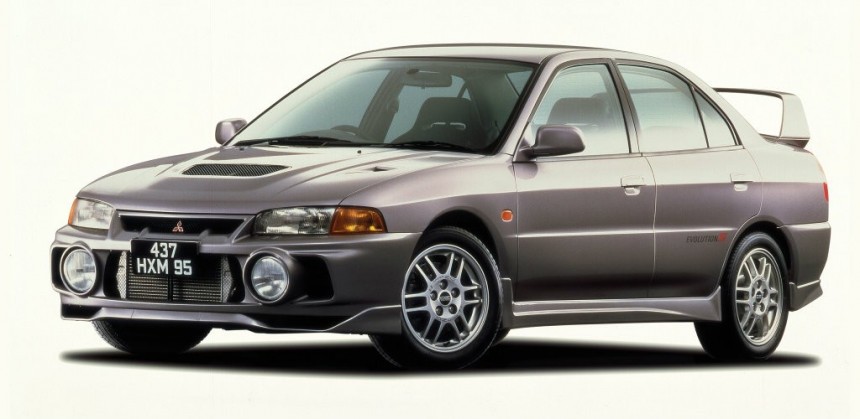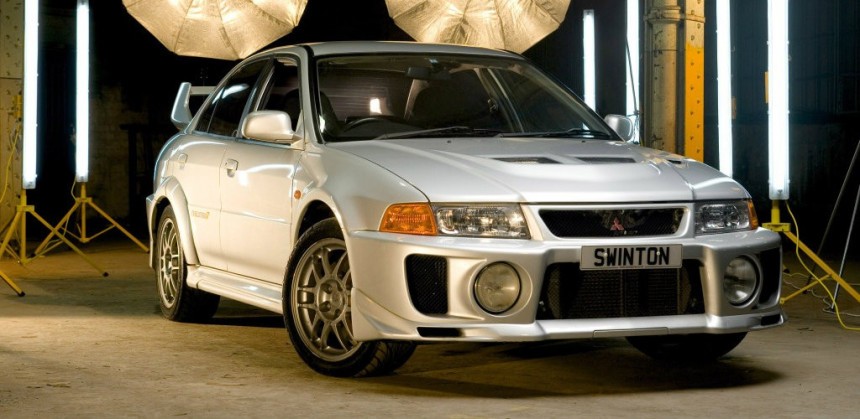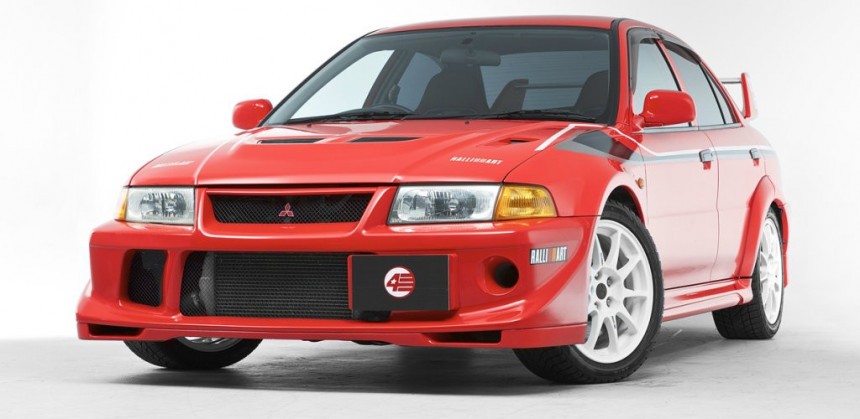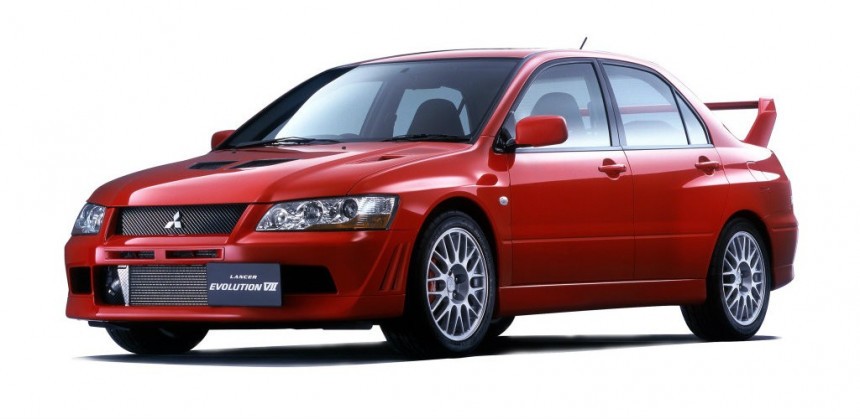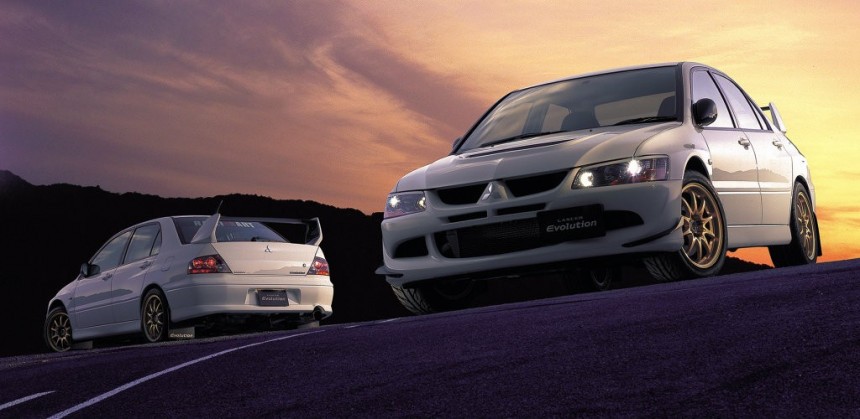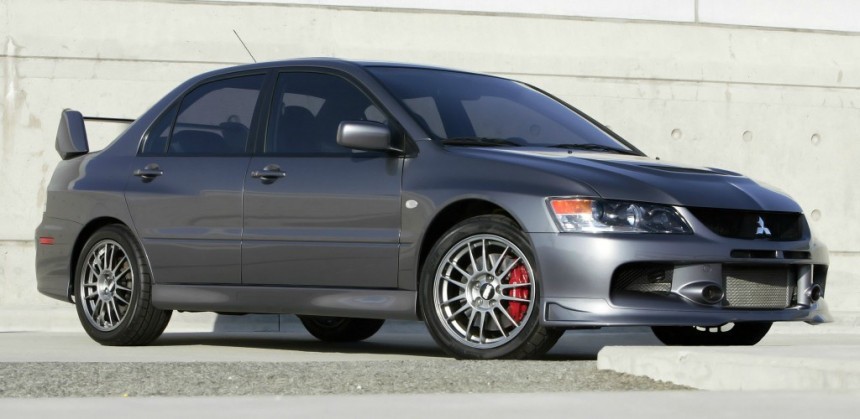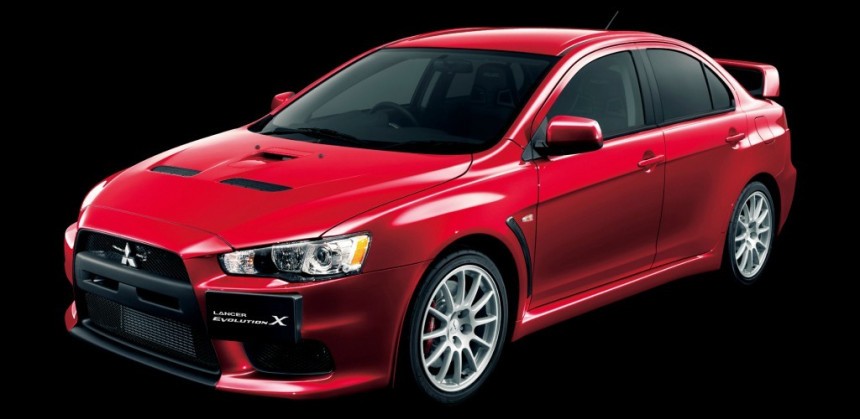Darwinism doesn't just apply to chimpanzees and cute little sea turtles. It applies to machines just as well. As far as driving machines are concerned, each of the Mitsubishi Lancer Evolution's ten generations was better than the last.
Today, let's take a deep dive into perhaps the most wonderful performance vehicle ever to come out of Japan through each of its wonderful evolutions. (See what we did there?)
1992 Mitsubishi Lancer Evolution I (CD9A): A Beautiful Beginning
Before the Evolution blessed us with its presence, Mitsubishi established itself off the beaten path with the 500 Super Deluxe of the 1960s, the Lancer 1600 GSR of the 1970s, and a Pajero that won the Paris-Dakar rally in 1985. The predecessor to the first-gen Evolution was the groundbreaking Galant VR-4. A computer-operated AWD street beast with the same 2.0-liter turbo inline-four drivetrain that would come to be employed by the Mitsubishi Lancer Evolution I between ’91 and ’94.
The most iconic stalwart of the Galant VR-4 and all Evos henceforth was the 4G63T engine. From generations one through ten, this turbocharged four-pot was as consistent as an LS V8 was to a Corvette. From 247 PS (244 horsepower) and 309 Nm (228 lb-ft) of torque in the Evolution I, this rev-happy little four-banger was honed and tuned over the years to develop 291 PS (287 horsepower) and a bucketload of torque in the ninth generation of the Evolution. In an era where sports sedans pride themselves on massive engines, the EVO was a total change of pace.
The Evolution I RS is the most focused variant of the first-gen EVO. Aside from the rally car, of course. Compared to the creature comfort-laden GSR, the RS dieted to such an extent that it lost 154 pounds (70 kilograms) over the model it is based on. Oh, and another notable thing, the RS came with steelies and a mechanical plate-type limited-slip diff, not the viscous limited-slip rear differential of the GSR.
Some of the chassis adjustments include the longer wheelbase (2,510 mm or 98.8 inches compared to 2,500 mm or 98.4 inches), 10 mm (0.4 inches) wider tires, wider tracks, lighter swaybar, and a larger spoiler. For good measure, Mitsubishi engineers increased output to 256 PS (252 hp), and torque remained unchanged.
On the aesthetic front, there’s little in the way of differences between the EVO II and the EVO I. The Evolution has always been about small adjustments and the metamorphosis from first to second demonstrates this practice best of all.
The nips and tucks you can admire in the photograph above were made in the name of aerodynamics. See the nose molding? Designers worked back-to-back with the engineers to improve the air supply to the intercooler, radiator, and front brakes. The side skirts, rear bumper moldings, and rear spoiler were also developed for reduced lift at high speeds first and to look wicked when mounted on the car a very distant second.
Under the hood, output went up to 273 PS (270 horsepower), and torque stayed put at 309 Nm (228 lb-ft). Some of the most notable changes brought to the four-cylinder turbocharged engine include a higher compression ratio than before and a 16G turbocharger (TD05H-16G6) that is oh-so-familiar with the EVO crowd.
Not that anyone doubts the Mitsubishi Lancer EVO's racing credentials. But in case you did, the rally-spec Lancer Evolution III went on to win the drivers’ championship in the 1996 World Rally Championship thanks to the dazzling performance of Finnish rally driver Tommi Makinen. Makinen would win three more drivers titles with the Lancer EVO IV (’97), Lancer EVO V (’98), and Lancer EVO VI (’99).
Other than a heavier and stiffer platform, the EVO IV prides itself on in-house developed twin-scroll turbocharging technology, more power from the 4G63T engine (280 PS or 276 hp), and an active rear differential as part of the Active Yaw Control system.
Albeit simple by modern standards, the Active Yaw Control (AYC) system employs clever sensors and an electronic brain working harmoniously to redistribute the available torque to whichever of the four wheels needs it the most. Easy-peasy.
As for the interior, the Lancer Evolution V made the most of firm but supple Recaro seats. With the outer skin removed, you’ll notice subtle improvements like a master cylinder bore increased by 0.3 mm (0.01 inches). Alongside a strengthened engine with bigger injectors (560 cc instead of 510 cc) and more boost pressure for the turbo.
Compared to the 330 Nm (243 lb-ft) of torque developed at 4,000 rpm by the EVO IV, the fifth Lancer Evolution upped the ante to 373 Nm (275 lb-ft) at 3,000 rpm. This makes up for a striking difference in off-the-line acceleration. By association, that meant better handling in the corners and faster quarter-mile drag race times. Even by European standards, the EVO V was nothing short of effective. Maybe even downright charmingly wonderful.
To do that, Mitsubishi engineers beefed up the EVO VI with a larger oil cooler and intercooler, replaced old pistons with new, lighter ones, and a whole slew of other highly technical items. The RS, however, prides itself on a titanium-aluminide turbine wheel.
For those who wanted the go-faster credentials of the RS but with the creature comforts of the GSR, the Lancer Evolution VI is also available in an extra spicy RS2 flavor. Other than the added well-being, the RS2 is the first EVO model to be equipped with ABS brakes, a safety feature that became the standard in Europe in 2004.
MMA jokes aside, the gain in weight was noticeable. The EVO VII made up for this handicap with some chassis tweaks, the most important being the active center differential, better rear limited-slip diff, and the front helical limited-slip differential. Power also took a marginal increase. As if Mitsubishi could get away without doing that.
Taken together, the active center differential and Active Yaw Control system improved the turn-in of the EVO VII. Other than the sharp steering, the focal points of the Lancer Evolution VII allow for arse-out action with little effort from the driver. It's a key part of the EVO VII's reputation as one of the best drivers cars never to step foot in North America when new.
In the case of the face-meltingly powerful FQ 400, sold in the United Kingdom through Ralliart, there’s a bit of a witticism surrounding its FQ acronym. The word that starts with F stands for the best fun one can have while naked. Q, on the other hand, stands for quick. We'll take their word for it on that one. In fairness, it's not the most head-scratching naming scheme we've come accros. At least they bothered to be clever.
To clarify, yes, finally, the Lancer Evolution would feel North American soil under its tires with the EVO VIII. The bad news regarding the U.S.-spec EVO VIII is that it was initially available with a five-speed gearbox and didn’t come with that super-desirable active yaw control system JDM examples took advantage of. This was all much to the chagrin of American JDM fans who'd been salivating about buying an EVO since they first laid eyes on a performance car internet forum or played a Need for Speed franchise game.
The Japanese automaker built a meager 2,500 examples of these precious wagon things and sold them all in Japan. Once again making North American EVO fans grit their teeth as they watched people in the Far East smile as they whip around in these hot wagons.
As you can see in two pics featured in the gallery below, the EVO IX station wagon uses the rear end of the Lancer Sportback grafted onto the sedan. Despite how gruesome that sounds in writing, it was much more eye-pleasing in the flesh. If anything, it's one of the more handsome wagons we've come across from this era.
Though active yaw control was nowhere to be found, and it weighed considerably more than the regular EVO IX, the Mitsubishi Lancer Evolution IX wagon could carry a canoe on its roof and harass supercars at the same time. Best family car ever? Well, probably not, but it’s up there in the top ten. It might even place on the podium with its rival, the Subaru WRX STI.
2007 Mitsubishi Lancer Evolution X: A Chunky, But Wonderful Final Goodbye (CZ4A)
Oh boy, where do we start with the tenth iteration of the Lancer Evolution? For starters, it might seem like it's trying too hard to look like an EVO. Secondly, this is the first EVO to ditch the 4G63T for the all-aluminum GEMA 4B11T four-pot.
Another thing that made the Evolution X a bit of a downer with the EVO crowd is the fact that it can weigh as much as 1,600 kilograms (3,527 pounds). In colloquial terms, the Mitsubishi Lancer Evolution turned into a bit of a porker compared to the 1,170-kilogram (2,579 lb) gen-I EVO RS. If nothing else, it only shows how safety regulations can even make the slimmest sports cars look bloated and downright chunky.
When all is said and done, the most disappointing thing about the EVO X is that Mitsubishi sent it off with a Final Edition that churns out a very healthy 303 horsepower, up from 291. In spite of the extra heft, the EVO X's final electronics suite was the best Mitsubishi had ever applied to an automobile at that time. This meant this final EVO didn't have much trouble throwing around its vast bulk in the same way all its ancestors did.
That said, the Brits were profoundly luckier than the rest of the world because they alone had access to the cream-of-the-crop FQ-440 MR, a special edition that jetted a scarcely believable 450 PS (444 horsepower). That's muscle car V8 territory in a car with an engine the size of a medium-sized jug of milk. Test-driving by Jeremy Clarkson and a time-lap by the Stig gave the impression this outrageously over-boosted GQ-440 could blow its top at any time. But hey, that's a part of the fun of the EVO. Their engines can handles boost like nobody's business.
When you look at the state Mitsubishi finds itself just a month before 2023 kicks off, one gets the impression the brand lacks a certain soul about it that the company used to take for granted. With only the pipsqueak Mirage to offer as a non-SUV on from Mitsubishi, the company seems to be failing to capture the essence of what used to make them great. All the while, they seem to be failing at trying to market a cheap, reliable family car with the same effectiveness as Honda and Toyota.
If you ask us, we think that bringing back the EVO for an 11th-generation would be the best possible way to put positive narratives around a brand that doesn't have all that many good graces in North America anymore. But hey, we're just auto journalists. What the heck do we know!? As it happens, a lot more than some auto execs will give us credit for.
Check back soon for some of the most in-depth car profiles on the web here on autoevolution.
Before the Evolution blessed us with its presence, Mitsubishi established itself off the beaten path with the 500 Super Deluxe of the 1960s, the Lancer 1600 GSR of the 1970s, and a Pajero that won the Paris-Dakar rally in 1985. The predecessor to the first-gen Evolution was the groundbreaking Galant VR-4. A computer-operated AWD street beast with the same 2.0-liter turbo inline-four drivetrain that would come to be employed by the Mitsubishi Lancer Evolution I between ’91 and ’94.
The most iconic stalwart of the Galant VR-4 and all Evos henceforth was the 4G63T engine. From generations one through ten, this turbocharged four-pot was as consistent as an LS V8 was to a Corvette. From 247 PS (244 horsepower) and 309 Nm (228 lb-ft) of torque in the Evolution I, this rev-happy little four-banger was honed and tuned over the years to develop 291 PS (287 horsepower) and a bucketload of torque in the ninth generation of the Evolution. In an era where sports sedans pride themselves on massive engines, the EVO was a total change of pace.
1994 Mitsubishi Lancer Evolution II (CE9A): The Vital Second Step
Mitsubishi commenced production of the second-gen Evolution in December 1993 and sunsetted the model in February 1995. Compared to the CD9A platform of the first EVO, the CE9A-based Evolution II brought handling improvements and enough extra muscle to be noticeable.
Some of the chassis adjustments include the longer wheelbase (2,510 mm or 98.8 inches compared to 2,500 mm or 98.4 inches), 10 mm (0.4 inches) wider tires, wider tracks, lighter swaybar, and a larger spoiler. For good measure, Mitsubishi engineers increased output to 256 PS (252 hp), and torque remained unchanged.
1995 Mitsubishi Lancer Evolution III (CE9A): The Car That Taught Rally Racers How to Dominate
Based on the same architecture as the EVO II, the Lancer Evolution III is all about small improvements to the formula. It wouldn't be hyperbole to say the third-gen EVO is the one that defined how all going forward should look as far as the exterior is concerned.The nips and tucks you can admire in the photograph above were made in the name of aerodynamics. See the nose molding? Designers worked back-to-back with the engineers to improve the air supply to the intercooler, radiator, and front brakes. The side skirts, rear bumper moldings, and rear spoiler were also developed for reduced lift at high speeds first and to look wicked when mounted on the car a very distant second.
Under the hood, output went up to 273 PS (270 horsepower), and torque stayed put at 309 Nm (228 lb-ft). Some of the most notable changes brought to the four-cylinder turbocharged engine include a higher compression ratio than before and a 16G turbocharger (TD05H-16G6) that is oh-so-familiar with the EVO crowd.
1996 Mitsubishi Lancer Evolution IV (CN9A): Like a Top of the Line PC With a Steering Wheel
Let's be frank for a moment. There's hardly a soul on this Earth that wouldn't want the EVO IV parked in their dream garage. Everything about this flagship Mitsubishi, from the large fog lamps to the aggressive-looking hood, makes people's petrolhead senses kick into overdrive.Other than a heavier and stiffer platform, the EVO IV prides itself on in-house developed twin-scroll turbocharging technology, more power from the 4G63T engine (280 PS or 276 hp), and an active rear differential as part of the Active Yaw Control system.
1998 Mitsubishi Lancer Evolution V (CP9A): A Whole New Layer of Refinement
The successor of the fourth is a more gung-ho affair as far as the exterior design is concerned. Check out those flared wheel arches that hide the wider front and rear tracks! Better still, the rear wing of the EVO V is adjustable. This fact will certainly impress the ladies on a first date... or not. No, definitely not, sorry folks!As for the interior, the Lancer Evolution V made the most of firm but supple Recaro seats. With the outer skin removed, you’ll notice subtle improvements like a master cylinder bore increased by 0.3 mm (0.01 inches). Alongside a strengthened engine with bigger injectors (560 cc instead of 510 cc) and more boost pressure for the turbo.
1999 Mitsubishi Lancer Evolution VI (CP9A): A Timeless JDM Hero Car
Ah, the sixth Lancer Evolution in Tommi Makinen Edition flavor. Oh, how we all miss the 1990s. That's why this article was written on a Pentium II DOS box (kidding). Daydreaming aside, the EVO VI wasn’t all that different from its predecessor apart from the improved cooling and durability of the 4G63T engine.To do that, Mitsubishi engineers beefed up the EVO VI with a larger oil cooler and intercooler, replaced old pistons with new, lighter ones, and a whole slew of other highly technical items. The RS, however, prides itself on a titanium-aluminide turbine wheel.
2001 Mitsubishi Lancer Evolution VII (CT9A): Y2K, Meet 4G63
Because it was based on the Lancer Cedia platform, the EVO VII grew a fair bit over its predecessor. When equipped with all the bells and whistles available in the options list, the EVO VII can surpass the 1,400-kilogram (3,086-pound) mark. Practically a featherweight by modern standards, but it was like UFC Heavyweight Champion-era Brock Lesnar compared to the featherweight, Conor McGregor-adjacent curb weight the previous EVOs were known for.MMA jokes aside, the gain in weight was noticeable. The EVO VII made up for this handicap with some chassis tweaks, the most important being the active center differential, better rear limited-slip diff, and the front helical limited-slip differential. Power also took a marginal increase. As if Mitsubishi could get away without doing that.
2003 Mitsubishi Lancer Evolution VIII (CT9A): Welcome to America, You'll Love Your Stay
For the eighth installment of the rally-bred EVO franchise, Mitsubishi enhanced the new performance sedan's handling with Super Active Yaw Control. Another first for the Evolution line came with a butter-smooth and crisp six-speed manual transmission. Except for weight, more is always better, right? Unless it's oil leaks or rods knocking. Those aren't better at all.In the case of the face-meltingly powerful FQ 400, sold in the United Kingdom through Ralliart, there’s a bit of a witticism surrounding its FQ acronym. The word that starts with F stands for the best fun one can have while naked. Q, on the other hand, stands for quick. We'll take their word for it on that one. In fairness, it's not the most head-scratching naming scheme we've come accros. At least they bothered to be clever.
2005 Mitsubishi Lancer Evolution IX (CT9A / CT9W): Loved in Both Need for Speed and Real Life
A slightly updated EVO VIII? That'd be okay to call the EVO IX, at least for most people. You wouldn't be breaking any unspoken petrolhead rules for doing so. But then again, you’d be proven wrong by the subtle yet significant enhancements brought by Mitsubishi. For those who don't know, there’s one other thing about the Lancer Evolution IX you shouldn’t take for granted. This is the first EVO to be offered as a wagon/estate car. Yes, a fan-bleedin’-tastic long roof that's so wonderful it puts a Eurobeat song in our hearts!The Japanese automaker built a meager 2,500 examples of these precious wagon things and sold them all in Japan. Once again making North American EVO fans grit their teeth as they watched people in the Far East smile as they whip around in these hot wagons.
As you can see in two pics featured in the gallery below, the EVO IX station wagon uses the rear end of the Lancer Sportback grafted onto the sedan. Despite how gruesome that sounds in writing, it was much more eye-pleasing in the flesh. If anything, it's one of the more handsome wagons we've come across from this era.
2007 Mitsubishi Lancer Evolution X: A Chunky, But Wonderful Final Goodbye (CZ4A)
Oh boy, where do we start with the tenth iteration of the Lancer Evolution? For starters, it might seem like it's trying too hard to look like an EVO. Secondly, this is the first EVO to ditch the 4G63T for the all-aluminum GEMA 4B11T four-pot.
Another thing that made the Evolution X a bit of a downer with the EVO crowd is the fact that it can weigh as much as 1,600 kilograms (3,527 pounds). In colloquial terms, the Mitsubishi Lancer Evolution turned into a bit of a porker compared to the 1,170-kilogram (2,579 lb) gen-I EVO RS. If nothing else, it only shows how safety regulations can even make the slimmest sports cars look bloated and downright chunky.
When all is said and done, the most disappointing thing about the EVO X is that Mitsubishi sent it off with a Final Edition that churns out a very healthy 303 horsepower, up from 291. In spite of the extra heft, the EVO X's final electronics suite was the best Mitsubishi had ever applied to an automobile at that time. This meant this final EVO didn't have much trouble throwing around its vast bulk in the same way all its ancestors did.
2022: Eight Years Later, The Loss Still Hurts
As of late 2022, there's no indication Mitsubishi plans to revive the EVO in any capacity. It appears the brand might be heading in the direction of selling badge-engineered Nissans instead. All the while, the EVO's cousin, the Eclipse, is having its name shamed by being applied to a crossover SUV. But whatever the future holds, one thing is for certain: the EVO will forever live in our hearts.When you look at the state Mitsubishi finds itself just a month before 2023 kicks off, one gets the impression the brand lacks a certain soul about it that the company used to take for granted. With only the pipsqueak Mirage to offer as a non-SUV on from Mitsubishi, the company seems to be failing to capture the essence of what used to make them great. All the while, they seem to be failing at trying to market a cheap, reliable family car with the same effectiveness as Honda and Toyota.
If you ask us, we think that bringing back the EVO for an 11th-generation would be the best possible way to put positive narratives around a brand that doesn't have all that many good graces in North America anymore. But hey, we're just auto journalists. What the heck do we know!? As it happens, a lot more than some auto execs will give us credit for.
Check back soon for some of the most in-depth car profiles on the web here on autoevolution.
